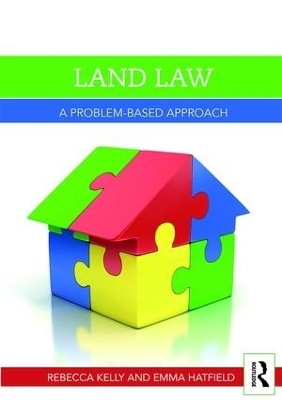
Land Law
Routledge (Verlag)
978-0-415-84490-1 (ISBN)
Problem-Based Learning is a way of learning that presents a practical problem scenario in the context of which learning is conducted. Normally students are taught law through the transmission of information about legal principles and not presented with problems until they have accumulated enough information to solve them. In PBL, discussion and analysis of the problem starts the process of learning, rather than acting as an end point. As a curriculum concept, it is becoming increasingly common in law schools as the use of problem scenarios helps to trigger awareness of legal issues and to engage interest by highlighting the real-world ramifications.
This new textbook creates a fresh approach to learning land law through the use of scenarios found in real-life which bring what is often perceived to be a dry and difficult subject to life. This helps both to engage the student and make the subject more accessible as well as demonstrating to students how land law actually operates in the real world. Land Law is often seen as an esoteric subject with lots of technicalities and complex vocabulary and students often forget the context in which it operates. With Land Law: A Problem-Based Approach, context is placed at the heart of learning. Students are learning through application rather than via an abstract set of rules and can therefore gain a deeper understanding of how land law works, not just what it is.
Unlike other textbooks, Land Law: A Problem-Based Approach integrates a thorough exposition of the law with practice, facilitating a more active learning approach and helping students to engage directly with the key cases and statutes to develop key skills of analysis, problem-solving and application. Written in a clear and concise style but without sacrificing detail or analysis, the book guides the reader towards a deeper understanding of the land law curriculum.
Key features include:
• An introductory chapter outlining the problem-based learning approach and how to use the book.
• Content overviews at the start of each chapter which provide a useful outline of the chapter’s content and the key principles
• PBL scenarios at the start of each chapter which provide the real-life context to each topic and help to familiarise readers with the legal language and style they will encounter. Together with the relevant supporting documents, these scenarios are referenced and integrated throughout the chapter
• ‘let’s put this into context’ boxes which require students to apply the law that they have learnt back to the problem scenario and offer opportunities to reflect and consolidate on the content covered
• Essential Cases and Essential Statutes boxes reinforce the essential role of cases and legislation in the development and application of land law and help students identify key cases and legislation for revision purposes
• Understanding Terminology boxes and an online glossary help students to get to grips with the technical terms and vocabulary unique to land law
• Tables and diagrams explain difficult concepts and rules, ideal for visual learners
• Tips and notes highlight key issues and make links between different aspects of the law without interrupting the flow of the text.
• Specimen exam-style questions are ideal for revision and help to provide opportunities to apply learning and practice exam technique
Emma Hatfield, LL.B(Hons), LL.M. FHEA is a senior law lecturer at the University of Huddersfield and a solicitor (non-practising). She teaches on all aspects of Land and Property Law and has written on areas of Commercial Property, Landlord and Tenant, Planning Law and Electronic Conveyancing. Emma’s particular research interest is electrification of the property system encompassing the transfer of property through non-paper based systems and their implementation. Rebecca Kelly LL.B(Hons), LL.M. FHEA is a senior law lecturer at the University of Huddersfield. She teaches on all aspects of Land Law in addition to Equity and Trusts and has written on several areas of law including Landlord and Tenant, Estoppel and Constructive Trusts. Rebecca’s particular research interest is in relation to pedagogy with particular reference to student learning, teaching techniques and professional skills development.
CONTENTS
Guide to the Problem-Based Learning Series
Guide to the Website
Table of Cases
Table of Statutes
CHAPTER ONE – AN INTRODUCTION (REBECCA KELLY)
Studying Land Law
Using the Problem-Based Learning (PBL) Approach in Land Law
Features of this book
How to use this book
CHAPTER TWO – PROPERTY RIGHTS IN LAND (REBECCA KELLY)
Chapter Aims and Objectives
Property Rights
Classification of Property
The definition of land
Ownership of land
Discussion section
End of chapter summary
Essay question
Problem question
CHAPTER THREE – COMMON LAW AND EQUITY (REBECCA KELLY)
Chapter aims and objectives
Common law and equity
Legal interests in land
The requirement of a deed
Equitable interests in land
Exceptions to the requirements of S2 LP(MP)A 1989
Enforcement of equitable interests
The 1925 property legislation
Discussion section
End of chapter summary
Essay question
Problem question
CHAPTER FOUR – UNREGISTERED LAND (REBECCA KELLY)
Chapter aims and objectives
Problems with the former system
Land charges
Overreachable equitable interests
Equitable interests remaining subject to the doctrine of notice
Discussion section
End of chapter summary
Essay question
Problem question
CHAPTER FIVE – REGISTERED LAND (REBECCA KELLY)
Chapter aims and objectives
The aims of the Land Registration Acts
Substantively registrable titles
Structure of the register of title
First registration of title
Grades of title
Dispositions of a registered title
Third party rights in registered land
Process for transfer of registered land
Altering the register
Discussion section
End of chapter summary
Essay question
Problem question
CHAPTER SIX – LEASEHOLD (EMMA HATFIELD)
Chapter aims and objectives
The Basics
Essential characteristics of a lease
Types of leases
Creation of leases
Determination of tenancies
Discussion section
End of chapter summary
Essay question
Problem question
CHAPTER SEVEN – LEASEHOLD COVENANTS (EMMA HATFIELD)
Chapter aims and objectives
The Basics
The running of covenants
Remedies for breach of covenant
Discussion section
End of chapter summary
Essay question
Problem question
CHAPTER EIGHT – LICENCES (REBECCA KELLY)
Chapter aims and objectives
Meaning and creation of a licence
Enforcement between the original parties
Enforcement between successors in title
Discussion section
End of chapter summary
Essay question
Problem question
CHAPTER NINE – EXPRESS, RESULTING AND CONSTRUCTIVE TRUSTS (REBECCA KELLY)
Chapter aims and objectives
Express trusts
Resulting and constructive trusts
Express agreement and detriment
Discussion question
End of chapter summary
Essay question
Problem question
CHAPTER TEN – TRUSTS OF LAND (REBECCA KELLY)
Chapter aims and objectives
Concurrent interests (co-ownership)
Successive interests
The trust of land
Powers of the court
Protection for purchasers
Discussion section
End of chapter summary
Essay question
CHAPTER ELEVEN – CO-OWNERSHIP (EMMA HATFIELD)
Chapter aims and objectives
The basics
The two forms of co-ownership
Legal and equitable title
Creation of joint tenancies and tenancies in common in equity
Severance of joint tenancy
The trusts of land and appointment of trustees act 1996
End of chapter summary
Essay question
Problem question
CHAPTER TWELVE – EASEMENTS (EMMA HATFIELD)
Chapter aims and objectives
The basics
The characteristics and qualities of an easement
Acquisition of an easement or profit
Prescription
Protection of easements and profits
Extinguishment of easement / profit
Discussion
End of chapter summary
Essay question
Problem question
CHAPTER THIRTEEN – MORTGAGES (REBECCA KELLY)
Chapter aims and objectives
Why have mortgages?
Meaning and the creation of a legal mortgage
Equitable mortgages
Rights of a mortgagor
Rights of the mortgagee
Discussion section
End of chapter summary
Essay question
Problem question
CHAPTER FOURTEEN – FREEHOLD COVENANTS (EMMA HATFIELD)
Freehold covenants
Chapter aims and objectives
The original parties and enforceability of the covenants
Enforceability of covenants by successors in title
Protection of covenants
Remedies
Discharge of restrictive covenants
Discussion section
End of chapter summary
Essay question
Problem question
CHAPTER FIFTEEN – ADVERSE POSSESSION (REBECCA KELLY)
Chapter aims and objectives
Justifications for adverse possession
The requirements for adverse possession
The effect of adverse possession
Human rights
Criminal law and adverse possession
Discussion section
End of chapter summary
Essay question
CHAPTER SIXTEEN – PROPRIETARY ESTOPPEL (REBECCA KELLY)
Chapter aims and objectives
The meaning of proprietary estoppel
Establishing proprietary estoppel
Satisfying the equity
The proprietary status of a claim
Discussion section
End of chapter summary
Essay question
CHAPTER SEVENTEEN – COMMONHOLD (REBECCA KELLY)
Chapter aims and objectives
The meaning of commonhold
The benefits of commonhold
The requirements for commonhold land
Termination of commonhold
Discussion section
End of chapter summary
CHAPTER EIGHTEEN – THE CONVEYANCING OF LAND (EMMA HATFIELD)
Chapter aims and objectives
Initial matters
First steps
Investigating title
Searches
Exchange
Pre-completion
Day of completion
Late completion and delayed completion
End of chapter summary
Essay question
Problem question
INDEX
| Erscheinungsdatum | 24.05.2016 |
|---|---|
| Reihe/Serie | Problem Based Learning |
| Zusatzinfo | 5 Tables, color; 36 Line drawings, color; 32 Line drawings, black and white |
| Verlagsort | London |
| Sprache | englisch |
| Maße | 174 x 246 mm |
| Gewicht | 1020 g |
| Themenwelt | Recht / Steuern ► EU / Internationales Recht |
| Recht / Steuern ► Privatrecht / Bürgerliches Recht ► Sachenrecht | |
| ISBN-10 | 0-415-84490-8 / 0415844908 |
| ISBN-13 | 978-0-415-84490-1 / 9780415844901 |
| Zustand | Neuware |
| Haben Sie eine Frage zum Produkt? |
aus dem Bereich


